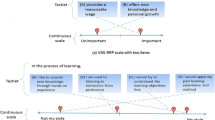Abstract
Performing a relational test on intervals is different than performing the equivalent relational test on points. The reason is that the difficulty making interval tests can vary. Simply evaluating difficult interval relational tests often produces inconclusive results. Formulating interval relational tests as crude range tests (CRTs) exposes the opportunity to introduce efficient CRT algorithms that use only the computing required to perform the test and obtain a conclusive outcome. Easy tests are therefore made relatively fast. Pillow functions are introduced to speed up efficient CRT algorithms.
Similar content being viewed by others
References
Forte™ (now known as Sun Java™ Systems) Developer 6 Fortran 95 update 2, Sun Microsystems, Inc. (July 2001).
J. Garloff and A.P. Smith, Investigation of a subdivision based algorithm for solving systems of polynomial equations, in: Proc. of the 3rd World Congress of Nonlinear Analysis (WCNA 2000), Catania, Italy, 2000.
E.R. Hansen, Global Optimization Using Interval Analysis (Marcel Dekker, New York, 1992).
E. Hansen and G.W. Walster, Global Optimization Using Interval Analysis, 2nd ed., revised and expanded (Marcel Dekker, New York/Basel, 2004) ISBN: 0–8247–4059–9.
R. Kearfott, Rigorous Global Search: Continuous Problems (Kluwer Academic, Dordrecht, 1996).
D. McAllester, P. Van Hentenryck and D. Kapur, Three cuts for accelerated interval propagation, Massachusetts Institute of Technology, Artificial Intelligence Lab., Memo No. 1542 (1980).
R.E. Moore, Interval Analysis (Prentice-Hall, Englewood Cliffs, NJ, 1966).
H. Ratschek and J. Rokne, Computer Methods for the Range of Functions (Halstead Press, New York, 1984).
P. Van Hentenryck, D. McAllester and D. Kapur, Solving polynomial systems using branch and prune approach, SIAM J. Numer. Anal. 34 (1997) 797–827.
P. Van Hentenryck, L. Michel and Y. Deville, Numerica. A Modeling Language for Global Optimization (MIT Press, Cambridge, MA, 1997).
G.W. Walster, The extended exterior interval system, Preprint, available at: http://www.mscs.mu.edu/~globsol/readings.html#Walster (August 1998).
G.W. Walster, The extended real interval system, Preprint, available at: http://www.mscs.mu.edu/~globsol/readings.html#Walster (March 1998).
G.W. Walster, Closed interval systems, http://wwws.sun.com/software/sundev/whitepapers/closed.pdf (August 1999).
G.W. Walster, Implementing the “simple” closed interval system, http://wwws.sun.com/ software/sundev/whitepapers/closed.pdf (February 2000).
G.W. Walster, SCAN 2000 keynote address: The future of intervals, in: Proc. of the SCAN 2000 GAMM–IMACS Internat. Symposium on Scientific Computing, Computer Arithmetic, and Validated Numerisc, 2000; available at www.math.uni-wuppertal.de/wrswt/literatur/official_book_v5_title_contents_preface_www.pdf.
G.W. Walster and V. Kreinovich, Computational complexity of optimization and crude range testing: A new approach motivated by fuzzy optimization, Fuzzy Sets Systems (2002) accepted for publication.
Author information
Authors and Affiliations
Rights and permissions
About this article
Cite this article
Walster, G.W., Hansen, E. Using Pillow Functions to Efficiently Compute Crude Range Tests. Numerical Algorithms 37, 401–415 (2004). https://doi.org/10.1023/B:NUMA.0000049484.69360.66
Issue Date:
DOI: https://doi.org/10.1023/B:NUMA.0000049484.69360.66




